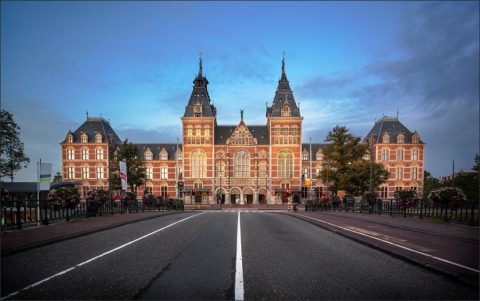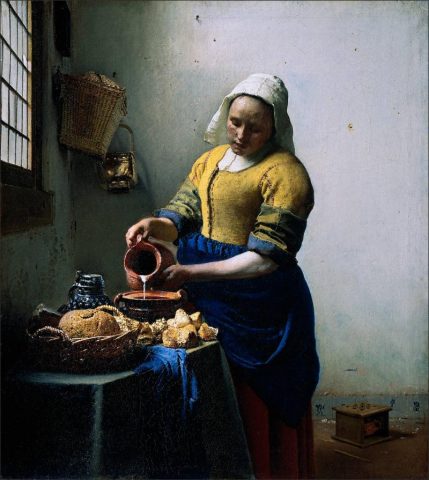The Rijksmuseum is certainly one of the greatest (if not the greatest) art museums in the world. It was originally housed on the upper floors of the Royal Palace on the Dam Square, was then transferred to the Trippenhuis on the Kloveniersburgwal in 1818, but then, in 1885, acquired its own home in this massive building at 42 Stad-houderskade, which was designed by P. J. H. Cuypers. He also designed the Centraal Station in Amsterdam, and you’ll notice similarities between the two buildings.
The hours of the Rijksmuseum (that means “National Museum”) are from 10 to 5 on weekdays and Saturdays, from 1 to 5 on Sundays. Immediately upon entering, go straight to the second floor, where you’ll see signs directing you on an itinerary of rooms that eventually leads to the large gallery housing the “Night Watch.” Initially, as you walk through these rooms, you’ll encounter Dutch art of the 16th Century; later the breathtaking 17th Century begins, represented by such marvels as Ruysdael’s “The Mill at Wijk bij Duur-stede,” the witty paintings of Jan Steen, countless others.
Then, four rooms before the “Night Watch,” there appear paintings by “the school of Rembrandt,” beginning first with several works by his most famous students and apprentices—Gerard Dou, Ferdinand Bol, Govert Flinck, Nicolaes Maes—and followed then by three glorious rooms of paintings (any museum in the world would be lucky to have one) by the master himself: “Samson and Delilah”; a famous Self-Portrait; a portrait of his mother; and of Saskia; Titus; “The Oriental Potentate,” “The Jewish Bride” (done in tones of gold and red that seldom are even barely captured in reproductions, and slathered on with blobs of paint a quarter of an inch thick); and finally, “The Syndics of the Drapers’ Guild” (more popularly known as the “Staalmasters”), another famous regents’ piece (or corporate painting) done by Rembrandt late in his life, and designed to be hung in the old Cloth Hall of Amsterdam. The chief reputation of the Cloth Guild, by the way, was for honesty—an attribute reflected in a stern refusal ever to let a flawed bolt of cloth be shipped out of Amsterdam. Notice how Rembrandt captures this quality in his painting, which depicts the Staalmasters at a meeting, as they gaze out at a questioner from the floor.
Now, in the next and larger hall, there finally appears: the Night Watch, in which Captain Banning Coq and Lieutenant van Ruytenberg (the latter clad in a brilliant yellow jerkin with gold braid) go striding forth eternally into the fame that Rembrandt’s masterpiece alone brought them. Keep in mind that the painting has been considerably cut down from the original; if you’ll examine a small 17th Century copy displayed in a glass case at one side of the room, you’ll see how the original first looked.
It is thought, too, that the painting is not of a night scene at all, but that successive layers of protective varnish—now removed—once darkened the canvas much beyond Rembrandt’s intention; the purists argue that “Night Watch” is a misnomer, and simply call the painting, “The Company of Captain Frans Banning Coq and Lieutenant Willem van Ruytenburgh.” To appreciate the leap in art that Night Watch represents, look at the dull, uniformly-lighted regents painting by van der Heist, which is hung to the left of the Night Watch itself.
When you have seen the Night Watch, don’t prepare to leave the Museum, because something equally good is still to come. That’s found at the opposite end of the room from the Night Watch, where a short half-flight of stairs leads to several further rooms in which the small, cameo-like masterpieces of the great Johannes Vermeer (together with several lesser, but excellent, small paintings of Pieter de Hooch, and Gerard ter Borch) are hung: “A Street in Delft,” “A Maidservant Pouring Milk,” “Woman Reading a Letter,” “The Love Letter”; only 36 paintings remain of the work of Vermeer, and these four are among the greatest of them. Contrast their silent, exquisitely-composed style with the slashing, strong emotion that flows from Rembrandt’s portraits; the results, in any event, are enthralling, and you’ll surely want to pick up reproductions of the paintings at the sales desk of the Rijksmuseum, also on the second floor.
After you’ve returned to the room that houses the “Night Watch,” you can walk down a long “Gallery of Honor” where works of great foreign artists—Goya, Tintoretto, Veronese, among them— are hung. Downstairs, on the ground floor, are prints, etchings and watercolors of several different periods, together with a good deal of 18th and 19th Century art—but none of it comparable to the magnificent oils upstairs. The Rijkmuseum also houses a Department of Sculpture and Applied Art (furniture, Delftware, engraved glass, etc.), a print room of graphic art, a museum of Asiatic art (in the basement), and an art library. Schedule at least two hours for this remarkable institution, and be prepared to return time and again.
Hits: 31

